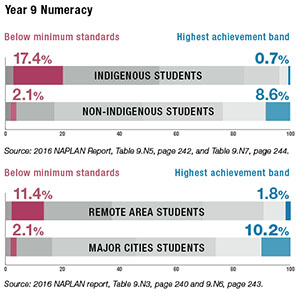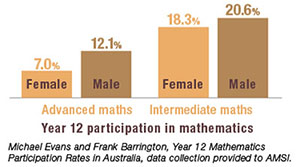Indigenous students failing to make the maths grade
 Indigenous students are eight times more likely to fall behind in maths by Year 9 than non-indigenous students, dampening regional innovation according to the Australian Mathematical Sciences Institute’s (AMSI) 2017 Discipline Profile of the Mathematical Sciences.
Indigenous students are eight times more likely to fall behind in maths by Year 9 than non-indigenous students, dampening regional innovation according to the Australian Mathematical Sciences Institute’s (AMSI) 2017 Discipline Profile of the Mathematical Sciences.
Figures in the Institute’s latest report card on the health of the mathematical sciences pipeline show at least 17.4 per cent of indigenous Year 9 students are below minimum maths standards by Year 9 compared to 2.1 per cent of their non-indigenous peers. This figure jumps to over 50 per cent in remote areas.
“This has disaster written all over it. Without a swift coordinated response, entrenched educational disadvantage will lock these students out of employment opportunities,” says AMSI Director, Prof Geoff Prince.
In an age of big data and automation, regional industry is increasingly reliant on a mathematically literate workforce. Low representation of indigenous and female students among Australia’s high maths achievers remains a challenge for skill supply.
 AMSI’s latest figures show only 0.7 per cent of indigenous students attained band 10 compared to 8.6 per cent of non-indigenous. Female participation also remains low with less than 7 per cent of Year 12 girls participating in advanced maths in 2016 compared to over 13 per cent of boys.
AMSI’s latest figures show only 0.7 per cent of indigenous students attained band 10 compared to 8.6 per cent of non-indigenous. Female participation also remains low with less than 7 per cent of Year 12 girls participating in advanced maths in 2016 compared to over 13 per cent of boys.
“20 years of low female participation and entrenched regional educational inequality continues to drive a maths deficit. If we do not build this capability, employers will seek skills overseas or relocate their research endeavour,” Prince said.
Out-of-field teaching and a mathematical skill deficit in the classroom are significant causes. In Australia, at least 26 per cent of Years 7 to 10 maths classes are taught by an out-of-field teacher. This climbs to over 40 per cent in regional and low socioeconomic areas, more than triple the international rate of 12 per cent.
To combat increasing teacher maths anxiety, AMSI is calling for on-the-ground professional development for existing regional and remote teachers and support staff to increase expertise and the retention of maths qualified teachers.
Recruitment of indigenous and female mathematics teachers from Australian university mathematical sciences departments remains a priority to boost classroom skill levels. With women accounting for only 23 per cent of the academic mathematical sciences workforce and only four AMSI member academics and 151 students out of 10,000 identifying as ATSI, underrepresentation has the Institute worried.
“These numbers do not bode well for future indigenous teacher supply. Without decisive action this will only contribute to the systemic cycle of disadvantage entrenched in these communities,” Prince said.